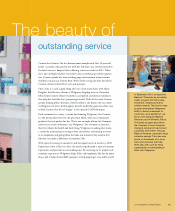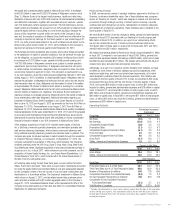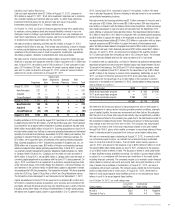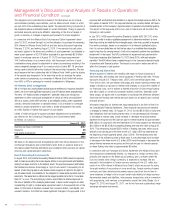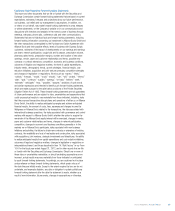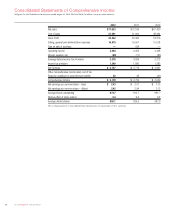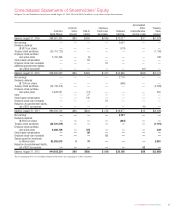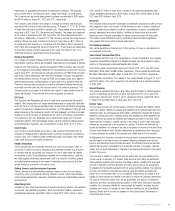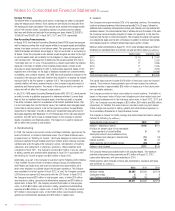Walgreens 2012 Annual Report Download - page 24
Download and view the complete annual report
Please find page 24 of the 2012 Walgreens annual report below. You can navigate through the pages in the report by either clicking on the pages listed below, or by using the keyword search tool below to find specific information within the annual report.In assessing our credit strength, both Moody’s and Standard & Poor’s consider
our business model, capital structure, financial policies and financial statements.
Our credit ratings impact our borrowing costs, access to capital markets and
operating lease costs.
On September 13, 2012, we completed the issuance and sale via an underwritten
public offering of $4.0 billion aggregate principal amount of senior unsecured notes
of varying maturities and interest rates, the majority of which are fixed rate. See Note
16 of Notes to the Company’s Consolidated Financial Statements. Approximately
$3.0 billion of the net proceeds of the offering was used to refinance the 364-day
bridge term loan described above and approximately $438 million was used to pay
the purchase price upon the closing of the USA Drug transaction described above
in September 2012.
Pursuant to our Purchase and Option Agreement with Alliance Boots GmbH, we have
the right, but not the obligation, to purchase the remaining 55% interest in Alliance
Boots during the period beginning February 2, 2015 and ending August 2, 2015.
If we exercise this call option, we would, subject to the terms and conditions of such
agreement, be obligated to make a cash payment of £3.133 billion (equivalent to
approximately $5.0 billion based on exchange rates as of August 31, 2012) and
issue approximately 144.3 million shares of our common stock, with the amount
and form of such consideration being subject to adjustment in certain circumstances
including if the volume weighted average price of our common stock is below
$31.18 per share during a period shortly before the closing of the second step
transaction. We also would assume the then-outstanding debt of Alliance Boots
upon the closing of the second step transaction.
Commitments and Contingencies
The information set forth in Note 11 to the Consolidated Financial Statements is
incorporated herein by reference.
Critical Accounting Policies
The consolidated financial statements are prepared in accordance with accounting
principles generally accepted in the United States of America and include amounts
based on management’s prudent judgments and estimates. Actual results may
differ from these estimates. Management believes that any reasonable deviation
from those judgments and estimates would not have a material impact on our
consolidated financial position or results of operations. To the extent that the
estimates used differ from actual results, however, adjustments to the statement
of comprehensive income and corresponding balance sheet accounts would be
necessary. These adjustments would be made in future statements. Some of the
more significant estimates include goodwill and other intangible asset impairment,
allowance for doubtful accounts, vendor allowances, asset impairments, liability for
closed locations, liability for insurance claims, cost of sales and income taxes.
We use the following methods to determine our estimates:
Goodwill and other intangible asset impairment – Goodwill and other indefinite-lived
intangible assets are not amortized, but are evaluated for impairment annually
during the fourth quarter, or more frequently if an event occurs or circumstances
change that would more likely than not reduce the fair value of a reporting unit below
its carrying value. As part of our impairment analysis for each reporting unit, we
engage a third party appraisal firm to assist in the determination of estimated fair
value for each unit. This determination includes estimating the fair value using both
the income and market approaches. The income approach requires management
to estimate a number of factors for each reporting unit, including projected future
operating results, economic projections, anticipated future cash flows and discount
rates. The market approach estimates fair value using comparable marketplace fair
value data from within a comparable industry grouping.
The determination of the fair value of the reporting units and the allocation of that
value to individual assets and liabilities within those reporting units requires us to
make significant estimates and assumptions. These estimates and assumptions
primarily include, but are not limited to: the selection of appropriate peer group
companies; control premiums appropriate for acquisitions in the industries in
which we compete; the discount rate; terminal growth rates; and forecasts of
revenue, operating income, depreciation and amortization and capital expenditures.
The allocation requires several analyses to determine fair value of assets and
liabilities including, among other things, purchased prescription files, customer
relationships and trade names. Although we believe our estimates of fair value
are reasonable, actual financial results could differ from those estimates due to the
inherent uncertainty involved in making such estimates. Changes in assumptions
concerning future financial results or other underlying assumptions could have
a significant impact on either the fair value of the reporting units, the amount
of the goodwill impairment charge, or both.
We also compared the sum of the estimated fair values of the reporting units to
the Company’s total value as implied by the market value of the Company’s equity
and debt securities. This comparison indicated that, in total, our assumptions
and estimates were reasonable. However, future declines in the overall market
value of the Company’s equity and debt securities may indicate that the fair
value of one or more reporting units has declined below its carrying value.
One measure of the sensitivity of the amount of goodwill impairment charges to
key assumptions is the amount by which each reporting unit “passed” (fair value
exceeds the carrying amount) or “failed” (the carrying amount exceeds fair value)
the first step of the goodwill impairment test. Our reporting units’ fair values
exceeded their carrying amounts by less than 10% to more than 140%. The fair
value of one reporting unit exceeded its carrying amount by less than 10%.
Goodwill allocated to this reporting unit was $255 million at May 31, 2012. For
this reporting unit, relatively modest changes in the Company’s key assumptions
may have resulted in the recognition of a goodwill impairment charge. Our Long
Term Care Pharmacy’s goodwill was impaired by $16 million in fiscal 2010 as a
result of the asset sale agreement with Omnicare, Inc., which was signed on
August 31, 2010.
Generally, changes in estimates of expected future cash flows would have a similar
effect on the estimated fair value of the reporting unit. That is, a 1% change
in estimated future cash flows would change the estimated fair value of the
reporting unit by approximately 1%. The estimated long-term rate of net sales
growth can have a significant impact on the estimated future cash flows, and
therefore, the fair value of each reporting unit. For the reporting unit whose fair
value exceeded carrying value by less than 10%, a 1% decrease in the long-term
net sales growth rate would have resulted in the reporting unit failing the first
step of the goodwill impairment test. Of the other key assumptions that impact
the estimated fair values, most reporting units have the greatest sensitivity to
changes in the estimated discount rate. A 1% increase in estimated discount
rate for the reporting unit whose fair value exceeded carrying value by 10% or
less would also have resulted in the reporting unit failing step one. The Company
believes that its estimates of future cash flows and discount rates are reasonable,
but future changes in the underlying assumptions could differ due to the inherent
uncertainty in making such estimates.
We have not made any material changes to the method of evaluating goodwill
and intangible asset impairments during the last three years. Based on current
knowledge, we do not believe there is a reasonable likelihood that there will be a
material change in the estimates or assumptions used to determine impairment.
Allowance for doubtful accounts – The provision for bad debt is based on both specific
receivables and historic write-off percentages. We have not made any material
changes to the method of estimating our allowance for doubtful accounts during
the last three years. Based on current knowledge, we do not believe there is a
reasonable likelihood that there will be a material change in the estimates or
assumptions used to determine the allowance.
Vendor allowances – Vendor allowances are principally received as a result of
purchases, sales or promotion of vendors’ products. Allowances are generally
recorded as a reduction of inventory and are recognized as a reduction of cost
of sales when the related merchandise is sold. Those allowances received for
promoting vendors’ products are offset against advertising expense and result
in a reduction of selling, general and administrative expenses to the extent of
Management’s Discussion and Analysis of Results of Operations
and Financial Condition (continued)
22 2012 Walgreens Annual Report



